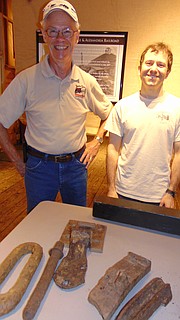Henry, 6½, and Sloan Speidell, 3½, color a train drawing at the Fairfax Station Railroad Museum. Photo by Steve Hibbard.
A few dozen people attended the Fairfax Station Railroad Museum’s special exhibit called “Memories of the Orange and Alexandria Railroad” on Sunday, Sept. 23. With 17 poster displays, it also featured original artifacts from the railroad – coupling equipment, a drawbar spring, track pieces, an old brake shoe – as it explored the construction, operation, and legacy of the founding railroad of Burke and Fairfax Station, which was completed in 1854.
According to Brian Slawski, Vice President, Burke Historical Society: “Burke got its name because of the railroad. Basically, Silas Burke became a member of the Board of Directors for the Orange and Alexandria Railroad when it was being planned. He realized he wanted the railroad to come through his back yard so he could ship his produce from his farm into the market in Alexandria. He persuaded his neighbors to give up some of their land to do the same, so they convinced the planners of the railroad to route it through what it became known afterwards as Burke Station, in his honor.”
He continued: “The railroad became the lifeblood of the community after that and passenger services were offered as well so people would benefit through the early 20th century – and now with Amtrak and the VRE using basically the same tracks, people from Burke are benefitting from that still.”
Michael Chinworth, Vice President of the Fairfax Station Railroad Museum, added: “What we’re trying to do today in cooperation with the Burke Historical Society is have an exhibit that tells visitors about what still remains and the changes that railroad brought to the area. What kind of evidence there is of the old railroad and what it means for historic preservation.”
Chinworth said the existence of the railroad connected parts of Northern Virginia with one another, adding: “So, it certainly didn’t hurt the emergence of Burke as a center for the county, as a more important location, as a town, as a city. The promoters of the railroad were looking to enhance their economic development. Alexandria was the terminus and Orange County was the Southern end.”
He said that Alexandria was an industrial area – a major seaport and everything west and south was agriculture. “So, the promoters of the railroad wanted to have a way for their goods and products to get out to the port so they could be sent to more distant markets and bring in benefits of the industrialized society to them. So, that was the intent (County Commissioner) Silas Burke had on his mind in promoting the station,” he said.
The station figured heavily during the American Civil War. It was the site of a massive evacuation effort during the Battle of Second Manassas (Bull Run) in 1862. The future founder of the American Red Cross, Clara Barton, tended to the wounded at St. Mary’s Church nearby and the depot.
He said the exhibit was a one-time deal; parts of it will become part of permanent display at the museum. For more information, visit http://fairfax-station.org.


